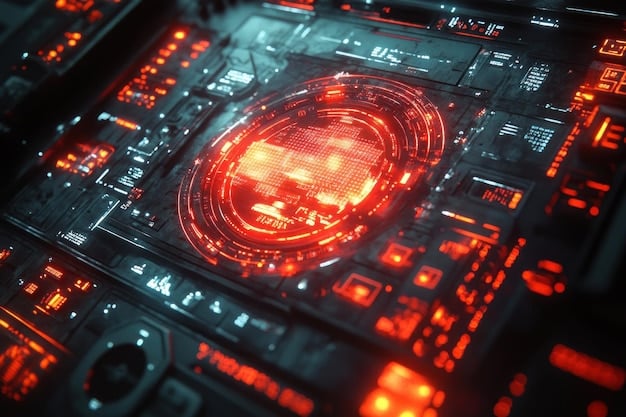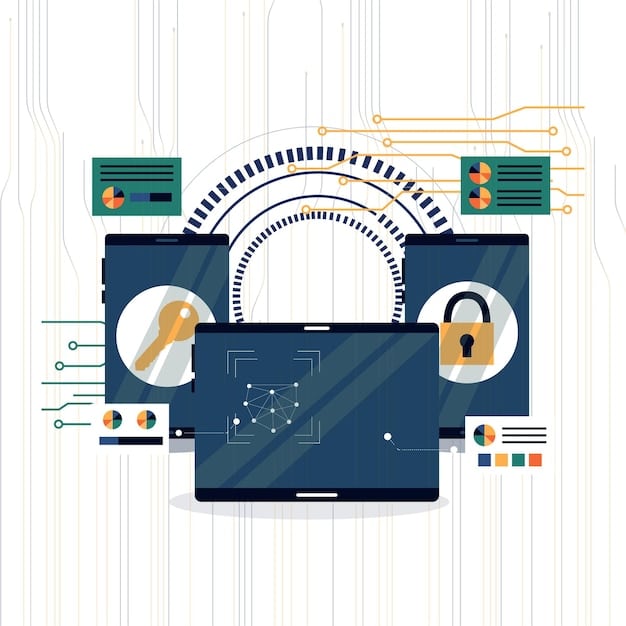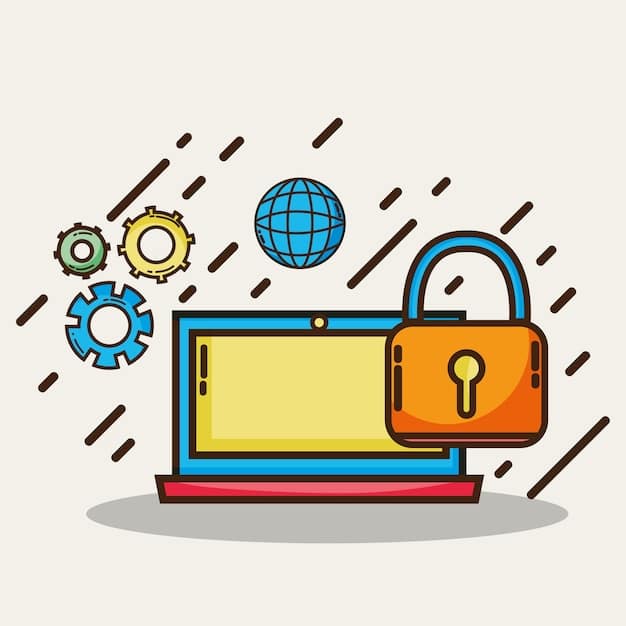New Anti-Cheat Software: Impact on PC Gaming Performance in 2025?

The latest anti-cheat software implementations in 2025 are designed to combat illicit gameplay effectively, yet early reports suggest a potential, albeit often subtle, impact on PC gaming performance, necessitating a closer look.
The digital battleground of PC gaming is constantly evolving, with developers and players alike striving for fair play. As we venture into 2025, a new generation of anti-cheat software has emerged, promising to curb cheating more effectively than ever before. But a pressing question weighs on the minds of many gamers: Is the new anti-cheat software impacting PC game performance in 2025? This article delves into the complexities of anti-cheat technology, its operational footprint, and the measurable effects it may have on your gaming experience.
The Evolution of Anti-Cheat Technology in 2025
The arms race between game developers and cheaters is perpetual, driving continuous innovation in anti-cheat solutions. In 2025, we’re seeing a shift towards more sophisticated, kernel-level anti-cheat systems designed to detect and prevent a wider array of illicit activities. These systems operate deeper within a computer’s architecture, making them significantly harder for cheaters to bypass.
These advanced methods are a direct response to the increasing prevalence and complexity of cheating tools, which can range from simple aim-bots to intricate memory manipulation programs. Developers are under immense pressure to maintain game integrity, as cheating can severely damage player retention and a game’s overall reputation. The current iteration focuses on proactive detection, often identifying suspicious behavior before it translates into a tangible in-game advantage.
From User-Mode to Kernel-Mode: A Deeper Dive
Historically, many anti-cheat solutions operated in user-mode, running as a regular application on the operating system. While effective against basic cheats, user-mode anti-cheat systems had inherent limitations, as more complex cheats could often hide themselves from detection by operating at a lower privilege level. This architectural vulnerability made it challenging to catch sophisticated cheaters who understood how to exploit these gaps.
The transition to kernel-mode anti-cheat marks a significant technological leap. Kernel-mode software operates at the highest privilege level on your computer, alongside essential operating system components. This grants it unparalleled access to system resources and processes, allowing for much more robust detection capabilities. This level of access is crucial for identifying cheats that attempt to interfere with game memory, inject code, or manipulate system calls in ways that user-mode software simply cannot observe. The trade-off, however, often involves concerns about system stability and potential performance overhead.
- User-mode benefits: Less intrusive, lower potential for system conflicts, easier to develop and implement.
- User-mode drawbacks: Limited access to system resources, easier for advanced cheats to evade detection.
- Kernel-mode benefits: Deep system access for comprehensive cheat detection, harder for cheaters to bypass.
- Kernel-mode drawbacks: Higher potential for system instability, increased resource utilization, privacy concerns.
The Promises of Enhanced Security
The primary goal of these next-generation anti-cheat systems is undeniably security. By operating at the kernel level, they aim to create a much more secure gaming environment. The promise is a drastic reduction in cheating, leading to a fairer and more enjoyable experience for legitimate players. This enhanced security is vital for competitive titles, where even a single cheater can ruin the integrity of a match and frustrate an entire player base. The reputation of a game often hinges on its ability to provide a level playing field, and 2025’s anti-cheat solutions are designed to uphold this principle.
This new wave of anti-cheat is also exploring more advanced heuristics and machine-learning algorithms. These intelligent systems can analyze player behavior patterns over time, differentiating between genuine skill and suspicious anomaly. This approach moves beyond simple signature-based detection, allowing anti-cheat to identify novel cheat methods even before specific patterns are identified. This adaptive learning capability is a powerful weapon in the ongoing war against game exploiters.
The evolution we’re witnessing in 2025 isn’t just about catching more cheaters; it’s about shifting the paradigm from reactive detection to proactive prevention. Developers are increasingly leveraging cloud-based analysis and real-time monitoring to identify and address cheat methods as they emerge, rather than waiting for them to become widespread. This rapid response capability is central to the efficacy of the new anti-cheat ecosystem.
Understanding the Mechanics: How Anti-Cheat Software Operates
To assess the impact on performance, it’s crucial to understand how modern anti-cheat software works behind the scenes. These programs are far from simple executables; they are complex suites of modules constantly monitoring your system for anomalies. They run in the background, scanning processes, memory, and network traffic for patterns indicative of cheating.
This constant vigilance requires computational resources. Every scan, every comparison, every data packet analyzed consumes a slice of your CPU, RAM, and potentially your network bandwidth. The challenge for developers is to design robust detection mechanisms that are also lightweight enough not to noticeable degrade the gaming experience for legitimate players. This balance is often difficult to strike, especially as cheats become more sophisticated and demand even deeper system inspection.

System Monitoring and Resource Allocation
Modern anti-cheat systems perform deep system monitoring. This involves actively inspecting various aspects of your computer’s operation while a game is running. They might scan for unauthorized programs running in the background, check the integrity of game files to ensure they haven’t been tampered with, and even analyze input devices to detect patterns associated with macros or external automation tools. This continuous surveillance means that the anti-cheat software is constantly utilizing system resources.
The resource allocation for these tasks can vary significantly depending on the specific anti-cheat implementation and the complexity of the game. Some systems are highly optimized, designed to minimize their footprint, while others might be more aggressive in their monitoring, potentially leading to higher CPU cycles or memory usage. The critical aspect is that this resource consumption directly competes with the game itself, which also requires substantial processing power and memory to run smoothly.
A well-designed anti-cheat aims for intermittent, highly targeted scans rather than continuous, blanket monitoring. They often prioritize scanning during less resource-intensive moments in the game, such as loading screens or static menus, to avoid impacting critical gameplay frames. However, the nature of advanced cheats often requires real-time, persistent monitoring, which inevitably introduces some level of overhead.
The Role of Kernel-Level Access in Resource Usage
As previously mentioned, kernel-level access grants anti-cheat software significant power. It can intercept system calls, inspect drivers, and monitor hardware interactions. While this depth of access is invaluable for catching sophisticated cheats, it also means the anti-cheat is deeply embedded within your operating system. This low-level operation can have a more pronounced impact on performance compared to user-mode solutions.
When anti-cheat software operates at the kernel level, it’s essentially acting as another core component of your operating system. Any inefficiencies in its code or overly aggressive monitoring routines can directly affect the responsiveness and stability of your entire system, not just the game. This is why kernel-level solutions face intense scrutiny and require rigorous optimization to avoid unintended side effects on performance. There’s a fine line between effective security and system degradation.
The debate around kernel-level anti-cheat often centers on this very point: the inherent trade-off between absolute security and potential system impact. While developers strive to make these systems as efficient as possible, the fundamental requirement to operate at such a deep level invariably brings with it a greater potential for resource contention and computational overhead.
The Direct Impacts on PC Game Performance
The question of whether anti-cheat software impacts performance isn’t a simple yes or no. The reality is nuanced, with various factors influencing the outcome. However, it’s generally accepted that any additional software running in the background, especially one that operates at a low system level, will consume some resources.
The key discussion point revolves around whether this consumption is significant enough to be noticeable to the average player. For high-end systems, the impact might be negligible, manifesting as a minor dip in frame rate or slightly longer load times. For older or less powerful PCs, however, these small impacts can accumulate, leading to a noticeably degraded gaming experience, including stuttering, frame drops, or even crashes.
Frame Rate (FPS) Fluctuations and Stuttering
One of the most commonly reported performance issues related to anti-cheat software is frame rate fluctuations and stuttering. Even if the average FPS remains high, inconsistent frame delivery can lead to a choppy and unpleasant gaming experience. This often occurs when the anti-cheat software performs an intensive scan or operation, temporarily spiking CPU or disk usage, which then starves the game of necessary resources.
This phenomenon is particularly noticeable in fast-paced competitive games where consistent frame times are paramount. A sudden drop in FPS or a micro-stutter, however brief, can lead to missed shots or inaccurate movements, turning a potentially successful play into a frustrating failure. Developers are actively working to optimize these background processes to minimize such disruptions, but it remains a persistent challenge.
- Common complaints: Unpredictable frame drops, intermittent hitches, noticeable stuttering during critical moments.
- Contributing factors: Intensive background scans, real-time data analysis, conflicts with other system processes.
- Impact on gameplay: Reduced responsiveness, difficulty in aiming, overall less fluid experience.
Increased CPU and Memory Usage
Anti-cheat software, by its very nature, demands CPU cycles and memory. Monitoring processes, encrypting communications, and analyzing game data are all computationally intensive tasks. While individual anti-cheat solutions vary, many users report seeing a noticeable increase in CPU utilization and RAM consumption when a game with robust anti-cheat is active.
This increased resource usage can be particularly problematic for systems that are already resource-constrained. If your CPU is constantly operating at near 100% capacity due to the game and anti-cheat combined, other background tasks, or even the operating system itself, can suffer. Similarly, higher memory usage means less available RAM for the game, potentially forcing the system to rely more on slower disk-based virtual memory, leading to further performance bottlenecks.
This is a critical area of optimization for anti-cheat developers. They must balance the need for comprehensive detection with the imperative to remain as light on system resources as possible. The trend in 2025 shows a focus on more efficient algorithms and smarter resource allocation, attempting to offload some processing to underutilized cores or scheduling scans during less demanding periods.
Measuring the Impact: Benchmarks and Player Experiences
Quantifying the exact performance impact of anti-cheat software is challenging, as it varies widely based on the specific anti-cheat, the game, the user’s hardware, and even the operating system configuration. However, independent benchmarks and widespread player reports offer valuable insights into the current state of affairs in 2025.
Benchmarking sites and tech reviewers often include testing methodologies designed to isolate the performance overhead attributable to anti-cheat. This usually involves running the same game build with and without the anti-cheat enabled (if technically possible and permissible), or comparing performance before and after a major anti-cheat update. These controlled tests provide the most objective data available.
Independent Benchmarks and Data Analysis
While direct comparisons can be difficult due to the proprietary nature and constant updates of anti-cheat software, many tech review sites and performance analysis channels conduct tests that shed light on the issue. These tests often involve measuring average frame rates, 1% low FPS, and frame timings in various games under different anti-cheat configurations.
What these benchmarks generally reveal is a subtle, but measurable, performance hit. It’s rarely a dramatic 20-30% drop across the board, but rather a consistent decrease in average FPS, often in the 3-7% range for high-end systems. For mid-range or budget PCs, this percentage can translate into a more significant absolute frame rate loss, potentially pushing games below comfortable playability thresholds. The “1% low” and “0.1% low” frame rates, which indicate the occasional significant dips in performance, often show a more pronounced negative impact, contributing to the feeling of stuttering.
Community Feedback and Anecdotal Evidence
Beyond the raw data, community feedback provides a crucial qualitative layer to understanding the impact. Gaming forums, social media, and dedicated subreddits are rife with discussions from players experiencing performance issues they attribute to anti-cheat. While anecdotal, the sheer volume and consistency of these reports indicate a widespread concern that cannot be ignored.
Players often describe scenarios where a game ran perfectly before an anti-cheat update, only to experience noticeable stuttering or lower frame rates afterward. They might also point to increased load times or even situations where the anti-cheat software itself consumes a significant portion of system resources, even when the game is minimized or not actively running. These subjective experiences are powerful indicators of performance degradation, even if they don’t always align perfectly with quantitative benchmarks.
This qualitative data is particularly valuable because it highlights the “feel” of the game. A slight reduction in average FPS might not be statistically overwhelming, but if it translates into a less responsive or more jumpy experience, it significantly harms player satisfaction. The gaming community’s voice is a powerful force, often compelling developers to investigate and address perceived performance issues related to their anti-cheat solutions.
The Trade-off: Security vs. Performance in 2025
This ongoing discussion brings us to the core dilemma faced by game developers in 2025: the delicate balance between robust security and optimal performance. There’s an undeniable trade-off. The more deeply and comprehensively an anti-cheat system monitors a PC, the greater its potential impact on system resources and, consequently, game performance.
Developers are constantly striving to find the sweet spot – a system that is effective enough to deter and catch cheaters, but also efficient enough not to punish legitimate players with performance degradation. This is a moving target, as cheat developers continuously evolve their methods, forcing anti-cheat creators to adopt ever more aggressive and resource-intensive approaches.
Developer Challenges and Priorities
For game developers, the priority is often clear: maintain a fair playing field. A game riddled with cheaters quickly loses its player base and reputation. Therefore, investing in powerful anti-cheat solutions is a necessary, albeit costly and technically challenging, endeavor. They face immense pressure to keep their games cheat-free, especially in the highly competitive esports arena.
The challenge lies in integrating these complex systems without alienating their loyal players due to performance issues. Developers must meticulously test and optimize their anti-cheat deployments, often requiring significant post-launch patching and adjustments. User feedback, particularly concerning performance anomalies, plays a critical role in iterative improvements.
Future Outlook: Optimization and Balancing Acts
Looking ahead, the trend in 2025 suggests a continued focus on optimization. Anti-cheat developers are implementing smarter scanning algorithms, leveraging hardware-accelerated security features where available, and exploring cloud-based threat intelligence to reduce the load on individual player machines. The goal is to offload as much processing as possible without compromising the real-time detection capabilities.
There’s also a growing emphasis on transparency and communication. Developers are increasingly acknowledging the performance concerns related to anti-cheat and are working to be more open about how these systems operate and what measures are being taken to mitigate their impact. This dialogue helps build trust with the player base and manages expectations regarding potential performance trade-offs.
Ultimately, the future of anti-cheat software will be defined by its ability to strike this delicate balance. It needs to be a silent guardian, working effectively in the background without making its presence felt through stuttering frames or elevated CPU temperatures. The technology is rapidly advancing, and while a truly “zero-impact” anti-cheat remains a dream, the industry is moving towards more intelligent and less intrusive solutions.
Mitigating Performance Issues for Gamers
While the primary responsibility for optimizing anti-cheat software lies with developers, gamers are not entirely powerless. There are several steps players can take to minimize potential performance impacts and ensure their systems are running as efficiently as possible. A well-maintained PC, combined with smart configuration choices, can help smooth over some of the rough edges introduced by robust anti-cheat measures.
Understanding your system’s limitations and configuring your game and operating system accordingly can make a significant difference. Sometimes, a few simple tweaks can reclaim lost frames or reduce instances of stuttering, providing a more enjoyable and consistent gaming experience. It’s about empowering yourself to get the most out of your hardware, even when background processes are at play.
System Optimization Tips
Keeping your operating system and drivers up-to-date is fundamental. Graphics card drivers, in particular, often include optimizations for specific games and anti-cheat technologies. Regularly checking for and installing these updates can yield measurable performance improvements. Additionally, ensuring your Windows installation (or other OS) is updated helps maintain system stability and efficiency.
Beyond updates, consider closing unnecessary background applications and processes when gaming. Every program running consumes RAM and CPU cycles, which directly compete with your game and the anti-cheat software. A clean taskbar and a lean system tray can free up valuable resources. Running a task manager to identify resource-hungry applications can help you determine what to close before a gaming session.
Another crucial tip is to manage your power settings. Ensure your PC is set to “High Performance” in your power options, rather than a balanced or power-saving mode. These modes can throttle your CPU and GPU, negatively impacting gaming performance, especially when additional software like anti-cheat is active.
- Update drivers and OS: Keep graphics drivers, chipset drivers, and Windows up-to-date.
- Close background apps: Shut down browsers, launchers, and other non-essential programs.
- Adjust power settings: Set your PC to “High Performance” mode.
- Monitor temperatures: Ensure effective cooling to prevent thermal throttling.
Hardware Considerations for 2025
For those looking to upgrade or build a new PC in 2025, hardware choice plays an even more significant role in mitigating anti-cheat performance impacts. More powerful CPUs with higher core counts and faster clock speeds are better equipped to handle the simultaneous demands of a game and its background anti-cheat. Similarly, ample RAM (16GB or more) ensures there’s enough memory for all processes without resorting to slower virtual memory.
High-speed storage, particularly NVMe SSDs, can also improve load times and overall system responsiveness, which might indirectly lessen the perceived impact of anti-cheat during moments of data loading. While no hardware can completely eliminate anti-cheat overhead, a modern, well-balanced system provides a much larger performance buffer, making any small impact negligible.
When considering a new build, prioritize a CPU with strong single-core performance for gaming, and sufficient multi-core performance for background tasks. Look for motherboards with good power delivery and effective cooling solutions. These foundational hardware choices will generally lead to a more robust and responsive gaming experience, regardless of the anti-cheat software running.
The Ethics and Privacy Concerns of Kernel-Level Anti-Cheat
The discussion around anti-cheat software, especially kernel-level solutions, isn’t just about performance; it also touches on significant ethical and privacy concerns. Granting software deep system access inherently raises questions about data collection, system integrity, and potential vulnerabilities. These concerns are just as valid as performance impacts and contribute to the ongoing debate surrounding these essential security tools.
The trust required to allow a third-party application to operate at the kernel level is substantial. Users are essentially granting this software the ability to see and potentially interact with almost anything on their system. While developers generally assert that anti-cheat only monitors game-related processes, the technical capability to do more always exists, leading to apprehension among a segment of the PC gaming community.

Data Collection and Privacy Implications
Kernel-level anti-cheat software has the technical capacity to collect a vast amount of data from a user’s PC. This can include information about running processes, system configurations, hardware identifiers, and network activities. While anti-cheat developers typically state that only data relevant to cheat detection is collected and that personal information is anonymized, the sheer scope of access can be unsettling.
The lack of complete transparency regarding what data is collected, how it’s stored, and for how long, fuels privacy concerns. Gamers worry about their personal data being inadvertently exposed or used for purposes beyond cheat detection. This becomes a matter of trust between the player and the game developer/anti-cheat provider. Clear, concise privacy policies and independent audits could help alleviate some of these fears.
It’s not just about what data is actively collected, but also the potential for vulnerabilities. Any software operating at the kernel level represents a potential attack surface. A flaw in the anti-cheat software itself could, theoretically, be exploited by malicious actors, granting them unauthorized access to a user’s system. While developers employ rigorous security audit processes, the risk, however small, is non-zero.
The Balance Between Security and User Autonomy
The increasing intrusiveness of anti-cheat software forces a re-evaluation of user autonomy over their own computing devices. Should a player be forced to run a kernel-level driver to play a game they legitimately purchased? This question often sparks heated debate within the gaming community, highlighting a fundamental tension between the developer’s need for a cheat-free environment and the user’s right to control their computer.
Some argue that if a player wishes to participate in an online multiplayer environment, they implicitly agree to the measures necessary to ensure fair play, including robust anti-cheat. Others contend that no game should demand such deep system access without absolute transparency, clear ethical guidelines, and robust mechanisms for accountability. Finding a universally acceptable balance between these two perspectives remains one of the greatest challenges for the gaming industry in 2025 and beyond.
Potential solutions explored include more opt-in choices for kernel-level anti-cheat in non-competitive modes, or clearer distinctions between the levels of anti-cheat required for different game modes. However, for highly competitive titles, the pervasive nature of kernel-level anti-cheat seems set to continue as the dominant approach, leaving the ethical and privacy debate unresolved for many.
| Key Point | Brief Description |
|---|---|
| 🚀 Kernel-Level Shift | Anti-cheat in 2025 increasingly operates at the deepest system layer for enhanced detection. |
| 📉 Performance Impact | Measurable, subtle FPS drops (3-7%) and stuttering can occur, especially on older PCs. |
| ⚖️ Security vs. Speed | Developers balance robust cheat prevention with minimizing performance overhead. |
| 🔒 Privacy Concerns | Kernel access raises questions about data collection and system vulnerability for users. |
Frequently Asked Questions About Anti-Cheat and Performance
While most anti-cheat solutions consume some system resources, the degree of impact varies significantly. Kernel-level anti-cheat, common in 2025, tends to have a more noticeable, albeit often subtle, effect due to its deeper integration. Lightweight, user-mode solutions might have a negligible impact on modern hardware, but robust protection usually comes with some overhead.
You can monitor your CPU and RAM usage through Task Manager or third-party tools while gaming. Look for unusually high resource consumption from processes associated with the anti-cheat. Fluctuations in FPS, especially sudden drops or micro-stutters that weren’t present before an update, can also be indicators. Consider checking community forums for similar reports.
Reputable kernel-level anti-cheat software undergoes extensive testing and security audits. While it operates with high system privileges, developers assert it’s designed to monitor for cheating and not compromise your system. However, any software with deep system access carries an inherent, albeit small, risk of vulnerabilities or conflicts with other software. It’s a trade-off accepted for enhanced security.
Generally, no. For online multiplayer games featuring anti-cheat, the software is mandatory to launch and play. Attempting to disable it will typically prevent you from joining servers or even launching the game. Disabling anti-cheat would undermine its purpose, leaving the game vulnerable to cheaters. Developers enforce its presence for fair play.
The future in 2025 aims for more intelligent and less intrusive solutions. Expect increased use of AI and machine learning for behavioral analysis, offloading processing to the cloud, and better hardware-level integrations. The goal is to maximize detection effectiveness while minimizing the local system footprint, ultimately striving for a balance that optimizes both security and player experience.
Conclusion
The question of whether new anti-cheat software is impacting PC game performance in 2025 is met with a complex answer. While such systems are indispensable for maintaining fair play in competitive gaming, their deeper integration and sophisticated monitoring capabilities inevitably introduce a certain level of resource overhead. For some, particularly those with older hardware, this can manifest as noticeable frame rate drops, stuttering, or increased system utilization. For others with high-end machines, the impact might be negligible. The ongoing narrative is one of a continuous balancing act: developers striving for robust security against ever-evolving cheats, while simultaneously endeavoring to optimize performance and address valid player concerns regarding system impact and privacy. As technology advances, the hope is for anti-cheat solutions that are both highly effective and virtually invisible to the legitimate player.





